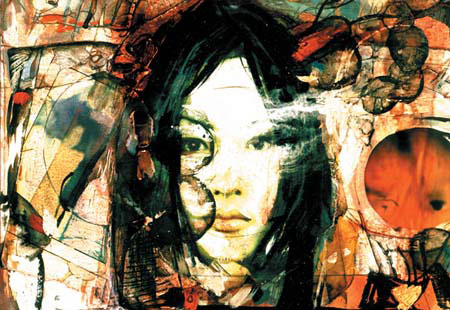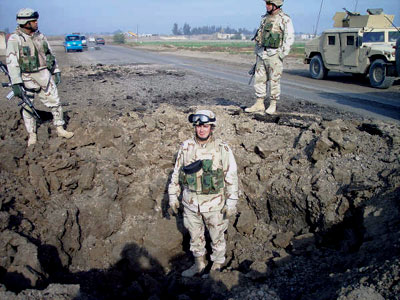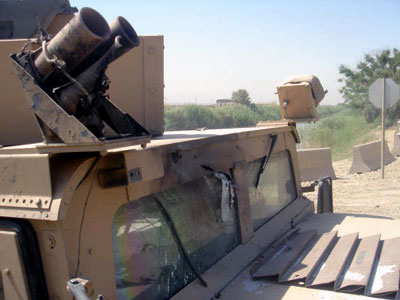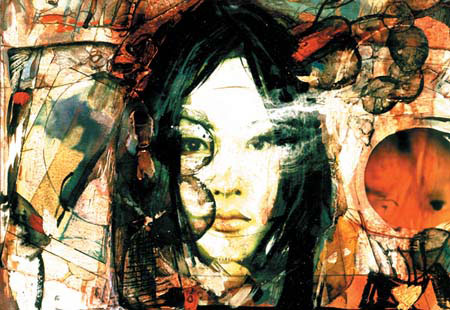
Reticulated Giraffe running. There are three subspecies of giraffes that live in East Africa: the Reticulated, whose spots are very clearly and cleanly marked; the Maasai, who are the tallest (up to 18 feet), darkest in color, and with spots going all the way down their legs; and the Rothschild, who are slightly smaller and lighter in color and have white “stockings.” (Marian Smith)
Matasha’s daughter squealed in delight when she saw the image of herself on my digital camera.
The miniature screen showed her — the tallest child in the group — surrounded by almost ten other skinny, dusty, grinning children. Matasha, my Maasai guide, towered over them, tall and proud, his robes a bright pinpoint of red against the brown and tan colors of the savannah.
In the background appeared the interior of Matasha’s family compound. A massive fence of gnarled, sharp branches enclosed a cluster of round huts made from dung and sticks. The family corralled its herd of cattle in the middle of the huts each night, protecting them from the lions that roam the stretch of plains between Kenya’s Chyulu hills and the majestic Mt. Kilimanjaro.
This was Campi ya Kanzi, 400 square miles of Maasai-owned land bordering the Tsavo West and Chyulu National Parks near the Amboseli Reserve in Kenya. Last summer, I stayed there with my boyfriend, Dan, and various members of my family, for four days at the beginning of a three-week-long safari through Kenya and Tanzania.
I squirmed the first time I saw where Matasha lived, unable to fathom why anyone would enjoy living in a hut made from dung. But at the end of my three weeks in Africa, after staying at other safari camps, I came to realize that the Maasai at Campi ya Kanzi were more than content with their traditional lifestyle and the dung huts that came with it; their culture was successfully withstanding any encroaching Westernization.
But I also realized that this fortunate state of affairs was allowed to happen only rarely. At most of the camps, ecotourism was simply a substitute word for high-priced wildlife-viewing expeditions. Locals weren’t given any stake in this version of tourism as nature conservation. At the same time, any notion of trying to preserve the local culture was practically unheard of. It was only at very few places, such as Campi ya Kanzi, that a pampered stay didn’t leave me with an uneasy conscience.
At Campi ya Kanzi, guests slept on feather pillows and Italian linens, enjoyed indoor plumbing in our canvas tents, and were supplied with soft white robes and slippers to wear at night. Each day, we woke up to a soft “Good morning” and the smell of freshly brewed coffee and sweet biscuits waiting on a tray on our private porch. During the day, we drove through endless miles of rolling bush, picnics packed in the trunk of our jeep, looking for wildlife with the help of our expert Maasai guides. And as the orange African sun began to set, we stopped on hilltops for our regular “sundowners” — wine and snacks — before heading back to camp.
The camp was the dream-come-true of Luca and Antonella Belpietro, a young couple from Brescia, in northern Italy. Ten years ago, Luca convinced Antonella to leave her chic life in Italy for the raw beauty of Kenya — the place where Luca had traveled extensively as a boy. Together, they discovered the Maasai-owned land in southern Kenya and formed a partnership with the 3,000 herdsmen living on it. With the Maasai’s help, Luca and Antonella built a main house and six cottages — with thatched roofs, rough wooden beams, and canvas sidings — for a maximum of 14 guests at any one time. They named the place Campi ya Kanzi, which means “Camp of the Hidden Treasure” in Kiswahili, and then invited people to come and see why.

Matasha, my Maasai guide, in traditional dress of red robes and beaded necklaces and bracelets. The spear in his right hand was with him always, a customary protection against wild animals when walking out in the bush. (Will Ebert)
Sustainable safari
Before I came to Campi ya Kanzi, I had been on a safari before, in the enormous Kruger National Park in South Africa almost 10 years ago.
I went with a friend’s family, and we stayed in unmemorable huts and drove ourselves around in a jeep, trying to avoid the seven-car pile-ups in which one or two cars would spot an animal and then five others would gather to form a rather — if I may say so — obnoxious crowd.
This was no Kruger.
For starters, there was only one other family and a honeymooning couple besides my family at Campi, and Luca and Antonella treated all of us as their personal guests. On our first day, they settled us into our tents, showed us around the grounds, and educated us on the history of the place. They also made very clear the camp’s mission — to raise money for schools and healthcare for the Maasai living anywhere within the extensive property, and to protect the wildlife.
That first day, Antonella explained that the wood for the camp’s construction came from sustainable tree plantations in nearby national forests, and that the water purifying system had been built out of the ubiquitous lava rocks of the Chyulu Hills. An organic vegetable garden provided the kitchen with its own natural produce, and the diesel generator* only ran for a few hours each day. Cards in our bathrooms told us that the little bottles of shampoos and soaps were biodegradable.
With an Italian eye for style, Antonella had decorated the lodge and the tents with local and traditional art: Beaded collars with strings of shells, ornate masks, and wooden carvings. Inside the main house, overstuffed sofas surrounded a large stone fireplace and heavy wooden chairs looked out across the open veranda to the mountains in the distance.
Most other camps lacked Campi’s rustic yet comfortable atmosphere.
Camp Kirawira in Tanzania, actively promoted its British colonial history, offering guests elaborate silver tea services laid out by local waiters wearing drab, grey uniforms and white gloves. Oriental carpets and old gramophones decorated the main house. Sure, the guides spoke flawless English and knew the Latin names of all the animals, but something didn’t feel quite right when a khaki-wearing man told us his tribe was Maasai. “Really?” I thought to myself and wondered where on the Serengeti he had bought his tan safari boots.
At Campi ya Kanzi, the Maasai were free to be themselves, red robes, spears and all. Along with the wildlife, they were the camp’s greatest assets.
Once, when we were in the bush on a game drive, Matasha called out to Stefano, our other guide and driver, to stop the jeep — he had seen an animal in the distance. I scanned the horizon eagerly, but even with binoculars glued to my face, I couldn’t see much besides trees and bushes.
Matasha said something to Stefano in Maa, the Maasai language.
“Ah, yes,” Stefano said, looking into the distance with his own pair of binoculars. Then he translated. “A young giraffe — Maasai — born maybe three months ago.”
I continued to look, all the while silently grumbling to myself. Then, something miles away moved, and sure enough, through my binoculars, I could just make out the silhouette of a young Maasai giraffe, one of the three main subspecies that can be found in East Africa. My binoculars were no match for Matasha’s eyesight, however, so I took his word for it that the animal was three months old.

Matasha’s daughter, center, wearing my hat and sunglasses. Other children surround her, and in the background is the gnarled fence that forms the corral for the family’s cattle each night. (Will Ebert)
Conversations about conservation
At dinner time, the whole camp — all of us guests, Luca, Antonella, their three-year-old daughter Lucrezia, Stefano, and sometimes a few of the Maasai guides who spoke English — sat around the large wooden table in the main house. Animal sightings — herds of elephant, gazelles, giraffes, and zebras — were discussed at great length as was the more serious issue of introducing certain rare species back into the region.
On one such evening, Luca told us of some poachers who had hidden the skinned carcass of a hartebeest — a kind of antelope — in a large bush in the hills of the Maasai land. He guessed that the poachers came from the Wakamba, another tribe that competes for resources with the Maasai, often resulting in tension between the two tribes. Luca resolved to gather a team of Maasai to go find the men.
The fierce ownership Luca displayed that night was equal to that of the Maasai, even though Luca is essentially a guest on their land. The two parties have built an extraordinarily strong and respectful partnership, and that is what makes Campi ya Kanzi unique in my eyes. Of the $425 per person per night fee, $30 goes to a charitable foundation that supports the Maasai culture — Luca meets with representatives from the community several times a year and together they decide how to allocate funds to schools, healthcare, and social projects. The rest of the money goes to sustaining the camp and its employees, and paying the salaries of the Maasai who work there or as scouts, patrolling the land for poachers.
In this way, as the Maasai work to conserve the wildlife on the reserve, they benefit from even the smallest number of tourists. In 2000, Luca and Antonella also set up the Maasai Wilderness Conservation Trust that contributes specifically to wildlife adoption and to reimbursing the Maasai for any damages to their herds caused by predators.
Showing the Maasai the benefits of protecting lions in particular was difficult at first since cattle, which the lions hunt, are the Maasai’s livelihood. Dowries are given in cattle, boys are given their first cows when they formally become men, and families are considered wealthy only by the number of cows they own. But slowly the Maasai have come to realize that the more lions there are, the more consistent the stream of tourists contributing to Campi ya Kanzi’s trust which, in turn, helps preserve the Maasai culture.
Years ago, Luca told me, a Christian missionary group tried to help the Maasai by building them a well so they would always have water. But after months of grazing their herds of cattle only on the surrounding grasses, the Maasai found that the land had become parched and the well was providing less and less water. The missionaries had meant well but their lack of cultural understanding blinded them to ways of helping that would still allow the Maasai to continue living their traditional nomadic life.

Matasha’s daughter, center, in a green dress, surrounded by other children. Behind them are two traditional huts constructed of dung, mud and sticks with a thatched roof. Inside, it is almost pitch dark and there are only a few fist-sized holes in the walls to let in light and release smoke from a small fireplace that burns in one corner. In the background is the corral’s fence, and behind that are the Chyulu Hills. (Will Ebert)
The pride of the Maasai
As guides, cooks, guards, and caretakers, the Maasai employees of the camp are not making their living by traditional means. But they do return to their villages on weekends and periodically throughout the year, and with the support of the foundation, they are all very likely living as closely as they can to their nomadic heritage.
When Matasha invited us to see his village, it became clear how respectful this reciprocal relationship between tradition and tourism can and should be. The visit with his family was not part of the tour — he was not being paid to show us a slice of Maasai life. Rather, he invited us as his guests. Matasha and his extended family live in essentially the same way his ancestors have lived for generations, and he was happy to show us the culture he was fighting to sustain.
In the dusty corral, Matasha’s wife watched over the assortment of children. By now, they had managed to extract the sunglasses and hat from my head and were gleefully chasing one another in their attempts to try them on. With his colorfully beaded wooden stick — a rungu — signifying leadership and power, Matasha motioned us toward one of the mud huts. Beaming, he told us it was his mother’s house.
Thinking about that day now, I can’t help but recall how the other safari camps spelled out in their brochures what it was like to visit a traditional village with their guides. They advertised it as an authentic experience, a unique opportunity to see where and how tribespeople had been living for generations. But when we realized that these “visits” actually entailed crowds of tourists piling into little vans to descend on these “villages,” where dollars could buy the beaded necklaces and postcards conveniently on display, we refused to sign up. It didn’t sit right, especially after Matasha had so generously invited us inside his own mother’s hut, where she slept, cooked, and lived her quiet life.
I must admit though that when I first saw Matasha’s home, it was difficult to reconcile the fact that I would be going back to a furnished, comfortable tent that night, while Matasha’s children would pile into their dung hut at bedtime. But seeing how happy they were — how proud — to live the way they did, brought home the fact that I was the only one feeling embarrassed about the disparity in our sleeping arrangements. Matasha and the other Maasai working at the camp saw the luxury of the guests’ lodgings every day, but they weren’t jealous. To them, our lifestyle was just another way of living.
Part of the beauty of traveling is learning to look at things from a new perspective, however clichéd that sounds. For the rest of my stay at Campi ya Kanzi, I stopped feeling guilt-stricken when I returned to my tent at night. That I slept on a feather pillow was of little consequence to the Maasai at Campi. Rather, what mattered to them (and to me) was that my visit was helping sustain a traditional way of life they did not want to lose. My conscience slept easier after that.

Matasha‘s daughter, center, in a green dress, surrounded by other children. Behind them is Matasha‘s mother‘s hut, constructed from dung, mud and sticks with a thatched roof. To the left is Stefano, Luca‘s long-time friend from school in Italy, who works at Campi ya Kanzi as a guide. (Will Ebert)
Correction, April 7, 2006: This article originally misstated that Campi ya Kanzi uses a solar-powered generator for a few hours each day. In fact, the camp uses a regular diesel generator for a few hours each day when it needs to run some heavy-duty appliances. The rest of the time, it uses solar-powered electricity. (Go to the corrected text.)
In The Fray Contributor
Dear Reader,
In The Fray is a nonprofit staffed by volunteers. If you liked this piece, could you
please donate $10? If you want to help, you can also:













